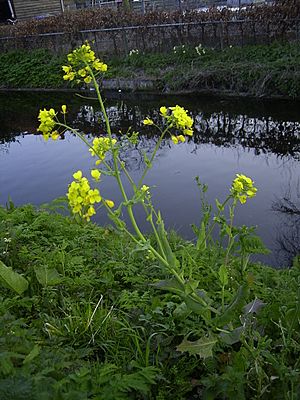Brassica facts for kids
Quick facts for kids Brassica |
|
|---|---|
 |
|
| Brassica rapa | |
| Scientific classification |
|
| Kingdom: | Plantae |
| Clade: | Tracheophytes |
| Clade: | Angiosperms |
| Clade: | Eudicots |
| Clade: | Rosids |
| Order: | Brassicales |
| Family: | Brassicaceae |
| Tribe: | Brassiceae |
| Genus: | Brassica L. |
| Species | |
|
See text |
|
Brassica is a group of plants that includes many common vegetables. These plants belong to the cabbage and mustard family, called Brassicaceae. You might know them as cruciferous vegetables, cabbages, or mustard plants. Sometimes, people call them cole crops. This name comes from the Latin word caulis, which means the stem or stalk of a plant.
Brassica plants are very important for farming and gardening. They also include some weeds that grow wild or have escaped from farms. Many Brassica plants are used for food. These include bok choy, broccoli, cauliflower, cabbage, kohlrabi, rutabaga, and turnip. Their seeds are also used to make canola oil and mustard.
There are over 30 wild types of Brassica plants. Plus, there are many different kinds grown by people. Most of these plants live for one or two years. But some can grow into small bushes. Scientists are very interested in Brassica plants because they are so important for food. Six special types of Brassica plants grew by combining parts from three older types. This idea is called the triangle of U theory.
These plants originally grew in Western Europe, the Mediterranean area, and warm parts of Asia. Today, many wild Brassica plants grow as weeds in places like North America, South America, and Australia.
Some people find vegetables like cabbage or broccoli taste bitter. This is because these plants have a special chemical in them. This chemical is similar to something called phenylthiocarbamide. Whether it tastes bitter depends on a person's taste buds.
Contents
Uses of Brassica Plants
Food Uses
You can eat many parts of Brassica plants. This includes their flowers, seeds, stems, and tender leaves. You can eat them raw or cooked. Farmers have grown these plants to make different parts bigger for food.
Here are some examples of Brassica parts we eat:
- Roots: Like swede and turnip.
- Stems: Such as kohlrabi.
- Leaves: Including cabbage, collard greens, and kale.
- Flowers: Like cauliflower, broccoli, and romanesco broccoli.
- Buds: For example, Brussels sprouts.
- Seeds: Used for mustard seed and oil-producing rapeseed.
Some Brassica plants with white or purple leaves or flowers are also grown just for their beauty. Many types of Lepidoptera (butterflies and moths) also eat Brassica plants when they are larvae (caterpillars).
Cooking Brassica
How you cook Brassica vegetables can change their nutrients. For example, boiling broccoli greatly lowers its levels of special compounds called glucosinolates. But other ways of cooking, like steaming, microwaving, or stir frying, do not change these levels much.
Types of Brassica Plants
Scientists sometimes disagree on how to group and name all the different Brassica types. Here is a short list of some important ones:
- Brassica balearica: This is also known as Mallorca cabbage.
- Brassica carinata: Called Abyssinian mustard. It is used to make biodiesel fuel.
- Brassica elongata: Known as elongated mustard.
- Brassica fruticulosa: This is Mediterranean cabbage.
- Brassica hilarionis: Also called St. Hilarion cabbage.
- Brassica juncea: This includes Indian mustard and brown mustard.
- Brassica napus: This is rapeseed, rutabaga, and Siberian kale.
- Brassica narinosa: Known as broadbeaked mustard.
- Brassica nigra: This is black mustard.
- Brassica oleracea: This group includes many common foods like kale, cabbage, collard greens, broccoli, cauliflower, kai-lan, Brussels sprouts, and kohlrabi.
- Brassica perviridis: Also called tender green or mustard spinach.
- Brassica rapa (also known as B. campestris): This group includes Chinese cabbage, turnip, and rapini.
- Brassica rupestris Raf.
- Brassica spinescens
- Brassica tournefortii: This is Asian mustard.
Plants Formerly in Brassica
Some plants used to be in the Brassica group but are now in other groups:
- B. alba or B. hirta (white or yellow mustard) is now Sinapis alba.
- B. geniculata (hoary mustard) is now Hirschfeldia incana.
- B. kaber (wild mustard or charlock) is now Sinapis arvensis.
Brassica Genetics
Scientists have worked to map out the entire genetic code, or genome, of rapeseed (canola, Brassica napus). This was done by a group of research organizations in 2009. The genome of B. rapa was also mapped in 2011. This helps us understand how these important plants grow and develop.
What's in a Name?
The name 'Brassica' comes from Pliny the Elder. He was a Roman writer who used this name for several plants that looked like cabbage.
See also
 In Spanish: Brassica para niños
In Spanish: Brassica para niños

